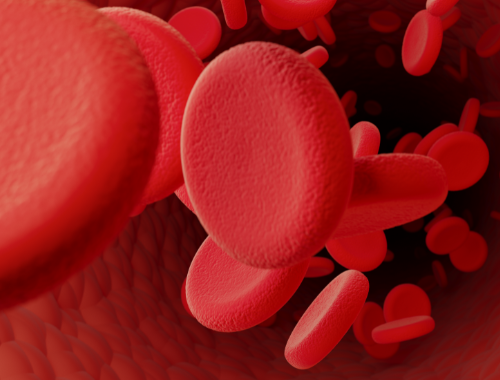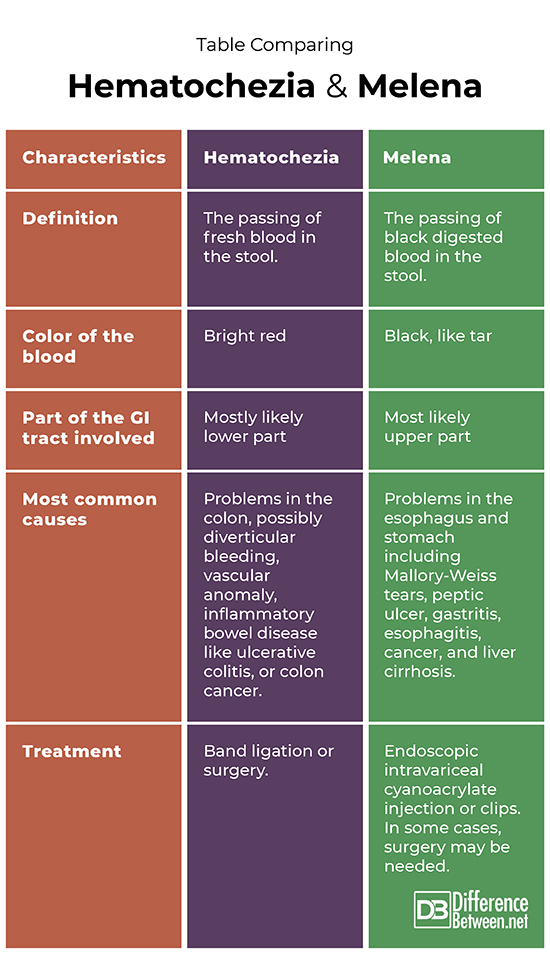Difference Between Hematochezia and Melena
Hematochezia is when fresh blood is passed along with stool. Melena is when blood that is black and tar-like is passed with the stool.

What is Hematochezia?
Definition:
Hematochezia is when fresh red-colored blood is evident in the stool.
Causes:
Red blood passed in the stool is most often due to bleeding in the distal or sigmoid colon. Conditions such as ulcerative colitis, diverticular bleeding, colon cancer, hemorrhoids, anal fissure, and angiodysplasia can cause hematochezia. However, rapid bleeding from higher up in the gastrointestinal (GI) tract can also produce hematochezia.
Diagnosis:
Diagnosis is by a combination of methods. A physical exam noting symptoms along with a digital rectal exam, a barium X-ray, and colonoscopy help discover sources of bleeding in the rectum and colon. A laparoscopic procedure may be done if the source of bleeding still cannot be found. Complete blood count and blood clotting tests are also done.
Symptoms:
There may be no obvious symptoms besides the blood in the stool but there can be cases where the patient has pain in the abdomen. Where a lot of blood has been lost, the person often faints or feels dizzy.
Treatment:
Surgery is needed where bleeding is severe. In the case of some hemorrhoids, band ligation can be used to clip off hemorrhoids.

What is Melena?
Definition:
Melena is when black stools occur due to the presence of digested blood.
Causes:
Bleeding is due to a problem in the upper gastrointestinal tract. Conditions such as peptic ulcer, Mallory-Weiss tears in the esophagus, and bleeding due to liver cirrhosis are common causes of melena. Esophagitis, gastritis, peptic and duodenal ulcers, and cancer in the stomach can also produce melena. The blood appears black in the stool because it has been partially digested by enzymes in the stomach and small intestine of the digestive tract.
Diagnosis:
Diagnosis relies on a physical exam along with a blood test, including a blood clotting test, and esophagogastroduodenoscopy (EGD). The EGD is the method by which the esophagus, stomach, and the first part of the duodenum are viewed. A breath test may be done to test for the presence of Helicobacter pylori, a bacterium that causes stomach ulcers.
Symptoms:
The presence of blood in the stool is the first symptom of melena. Later, as the bleeding continues the person may feel faint and they may have pain in the stomach or area which is bleeding.
Treatment:
Endoscopic intravariceal cyanoacrylate injection or clips can be used to stop bleeding in the upper GI tract. Both methods seal off areas of bleeding. Where a lot of blood has been lost, fluid and blood replacement may be needed to prevent shock.
Difference between Hematochezia and Melena?
Definition
Hematochezia is defined as the passage of fresh blood in the stool. Melena is the passage of digested black-colored blood with the stool.
Color of the blood
In the case of hematochezia, blood is bright red. In the case of melena, blood is black.
Part of the GI tract involved
Hematochezia is most of the time due to bleeding from somewhere in the lower GI tract like the colon or rectum. Melena is always bleeding from some part of the upper Gi tract, the stomach, or the esophagus.
Most common causes
The causes of hematochezia most often involve problems or conditions of the lower GI tract involving bleeding of the colon, rectum, and anus. Melena is caused by bleeding in the upper GI tract, the stomach, and esophagus.
Treatment
Band ligation or surgery is needed to control hematochezia. Melena can be treated surgically or by endoscopic intravariceal cyanoacrylate injection or clips.
Table comparing Hematochezia and Melena

Summary of Hematochezia Vs. Melena
- Hematochezia and melena are both conditions where blood is found in the stool.
- Both melena and hematochezia can be dangerous because they can lead to substantial blood loss.
- Surgery may be needed to stop bleeding in the upper or lower GI tract.
- Upper GI bleeding can be halted by endoscopic methods.
FAQ
What do melena and hematochezia indicate?
Both melena and hematochezia are indicative of bleeding somewhere in the gastrointestinal tract.
What is the cause of melena?
Melena is produced when there is bleeding in the upper GI tract such that the blood is partly digested by enzymes resulting in the black color when passed out of the body.
What is the difference between hematochezia and rectorrhagia?
In hematochezia, red blood is passed along with stool. Rectorrhagia is the passage of only red fresh blood from the anus, without any stool.
Is melena from upper or lower GI?
Melena is due to bleeding that occurs in the upper GI tract, in organs such as the esophagus or stomach.
What is the difference between melena and occult blood?
Occult blood is not visible to the naked eye. Melena is evident and visible in the stool. Occult blood, therefore, is only detected by completing a test on a stool sample.
Is hematochezia from upper or lower GI?
Hematochezia most commonly is from the lower GI. However, on rare occasions, very fast bleeding in the upper GI can sometimes result in hematochezia.
- Difference Between Rumination and Regurgitation - June 13, 2024
- Difference Between Pyelectasis and Hydronephrosis - June 4, 2024
- Difference Between Cellulitis and Erysipelas - June 1, 2024
Search DifferenceBetween.net :
Leave a Response
References :
[0]Ansari, Parswa. “Overview of gastrointestinal bleeding”. Merck Manual, 2021, https://www.msdmanuals.com/professional/gastrointestinal-disorders/gastrointestinal-bleeding/overview-of-gastrointestinal-bleeding
[1]Jones, F. Avery. "Hematemesis and melena: with special reference to causation and to the factors influencing the mortality from bleeding peptic ulcers." Gastroenterology 30.2 (1956): 166-190.
[2]Wilson, I. Dodd. "Hematemesis, melena, and hematochezia." Clinical Methods: The History, Physical, and Laboratory Examinations. 3rd edition (1990).
